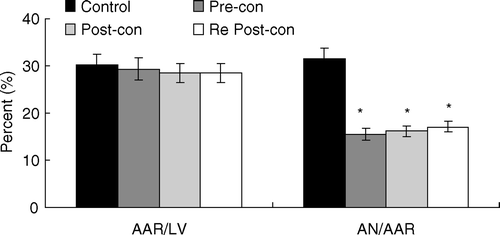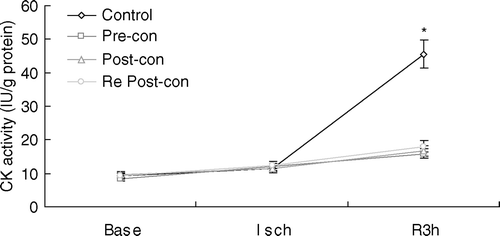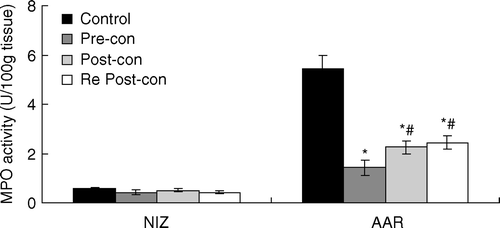Figures & data
Table I. HR (bpm) during ischemia and reperfusion
Table II. MAP (mmHg) during ischemia and reperfusion
Figure 1. Bar graph showing area at risk (AAR) expressed as a percentage of the left ventricle (LV) and area of necrosis (AN) expressed as a percentage of the AAR. Pre-con = Ischemic Preconditioning; Post-con = Ischemic Postconditioning; Re Post-con = Remote Postconditioning. Re Post-con significantly reduced AN/AAR ratio by 46% compared with Control, showing equivalent cardioprotection to that of Pre-con and Post-con. *p < 0.01 Pre-con, Post-con and Re Post-con vs. Control. Values are means±SD

Figure 2. Line graph showing plasma creatine kinase (CK) activity during the course of experiment. Base = baseline; Isch = end of ischemia; Pre-con = Ischemic Preconditioning; Post-con = Ischemic Postconditioning; R3h = 3 h of reperfusion; Re Post-con = Remote Postconditioning. Plasma CK activity at 3 h of reperfusion was significantly lower in Pre-con, Post-con and Re Post-con than that in Control. There was no statistical difference between Pre-con, Post-con and Re Post-con. *p < 0.01, Control vs. Pre-con, Post-con and Re Post-con at 3 h of reperfusion. Values are means±SD.

Figure 3. Line graph showing plasma malondialdehyde (MDA) levels during the course of experiment. Base = baseline; Isch = end of ischemia; Pre-con = Ischemic Preconditioning; Post-con = Ischemic Postconditioning; R3h = 3 h of reperfusion; Re Post-con = Remote Postconditioning. There was no significant difference among the four groups at baseline and after 30 min of ischemia. However, plasma MDA was significantly greater in Control at R3h compared to Pre-con, Post-con and Re Post-con. *p < 0.01, Control vs. Pre-con, Post-con and Re Post-con at 3 h of reperfusion. Values are means±SD.

Figure 4. Bar graph showing myeloperoxidase (MPO) activity in the NIZ and AAR. AAR = area at risk; NIZ = nonischemic zone; Pre-con = Ischemic Preconditioning; Post-con = Ischemic Postconditioning; Re Post-con = Remote Postconditioning. MPO activity in the NIZ was low and comparable among the four groups. However, MPO activity in the AAR was significantly less in Pre-con, Post-con and Re Post-con than that in Control. MPO activity in the AAR of Pre-con was significantly lower than that of Post-con and Re Post-con. *p < 0.01 Pre-con, Post-con and Re Post-con vs. Control. #p < 0.05 Post-con and Re Post-con vs. Pre-con. Values are means±SD.
